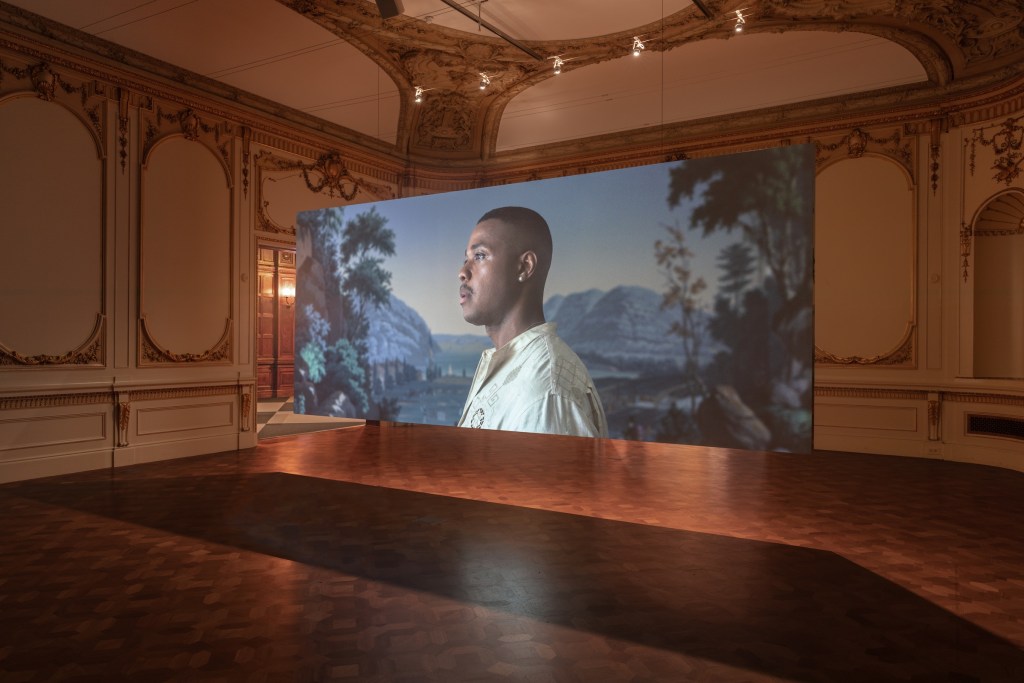The Smithsonian Design Triennial Reinvents Home


If the Cooper Hewitt, Smithsonian Design Museum, were a board game, it would be Clue — not for murder-mystery escapades but for the opulent maze of rooms in its expansive floor plan. Built at the turn of the 20th century as a home for one of the wealthiest Americans of all time, steel magnate and philanthropist Andrew Carnegie, the 64-room mansion sprawls over six floors with spaces that include, as in Clue, a library, study, and conservatory. It’s in this grand domestic setting that the museum’s seventh design triennial, Making Home, takes up residence.
Making Home marks the first time Cooper Hewitt has teamed up to present the triennial with the National Museum of African American History and Culture, a fellow Smithsonian institution and one that Trump specifically targeted in his executive order in March. Artists and designers render diverse facets of this edition’s “home” theme — including migration and transience, climate change and ancestral Indigenous knowledge, aging and assisted living, healthcare and genetics, memory and mourning — through works (all 2024) in a variety of mediums and materials.
However, some of today’s most pressing topics entangled with the meaning of home in the US that might also spring to mind — rocketing housing costs, housing shortages, homelessness — are either obliquely referenced or left out of the exhibition entirely, though some do get a bit more attention in the online exhibition and companion publication.
The concept of home is nevertheless a rich and expansive subject, as this survey makes clear, and design is an equally flexible lens for exploration. Featuring a wide-ranging medley of 25 newly commissioned installations with pliable interpretations of both home and design, Making Home takes visitors on a meander through the minds of artists and designers from the US, US territories, and Tribal Nations.

Lavender signage displayed on wooden plinths, designed by Office Ben Ganz, serves as a steady visual presence through the eclectic conceptual terrain and corresponds to a legend on the show’s map. If you start on the first floor and follow the map chronologically, treasure-hunt style, you’ll see the exhibition unfold in a loose arc of ideas. Installations grounded in domestic living spaces lead to investigations into the meanings, emotions, and realities of home and, finally, to solution-oriented offerings.
In the first section of the show, dubbed “Going Home,” site-specific installations riff on the architecture and original purposes of the Carnegie Mansion’s rooms. In Carnegie’s home office, Liam Lee and Tommy Mishima’s “Game Room” maps how the robber baron’s philanthropy continues to influence spheres of education, science, and foreign relations through tidy flowcharts and a Monopoly-style board game titled “Philanthropy.” With squares named for universities and environmental groups neighboring institutions behind dark chapters of US history, like Cold Spring Harbor Laboratory’s Eugenics Records Office, for one, the game underscores the complicated outcomes and shadows of the ultra-wealthy’s philanthropic initiatives. Inspired by the Underground Railroad’s clandestine network of pathways to freedom, the Black Artists and Designers Guild (BADG) transformed Carnegie’s personal library into an interactive space devoted to Black culture in “The Underground Library: An Archive of Our Truth.” Artworks by Black artists, such as Lana Abraham-Murawski’s aptly titled oil painting “Meeting of the Minds” (2021), line the walls, and you can pull books by Black authors from the shelves to read on undulating black sofas that sit atop a galactic carpet.

Further into the maze, a dining room vignette by Nicole Crowder and Hadiya Williams, titled “The Offering,” meditates on the search for home and belonging through the objects Black Americans carried with them during the Great Migration. And “Welcome to Territory” by the Lenape Center’s co-founder Joe Baker (Delaware Tribe of Indians) acknowledges the Lenape homeland, located where the mansion now stands, with a trio of turkey-feather capes suspended from the ceiling. They slowly rotate like spirit presences, surrounded by shimmering, painterly wallpaper printed with blossoming tulip trees, which were once plentiful in this area.
On the second floor, “Seeking Home” gathers installations loosely cohered around utopian visions of home, as well as institutions and systems like reproductive healthcare networks in Alabama and biobanks that house and preserve the blood samples and genetic material of millions of Americans. Mona Chalabi, a Pulitzer Prize-winning data journalist known for her hand-drawn data visualizations, partnered with SITU Research to present a stark look at domicide, the widespread or systematic destruction of homes, often during military conflict. On the walls of “Patterns of Life,” Chalabi’s distinctive cursive tells us that 40% of homes in Manbij, Syria; 65% of homes in Mosul, Iraq; and 70% of homes in Gaza have been damaged or destroyed as of March 2024. In the center of the room, a trio of ghostly white architectural models recreates apartment buildings that were destroyed in each location. You can peer into the windows to see layered illustrations of the lives once spent in these homes. This room feels deafening in its silence.

Nearby, a sweet scent emanates from Curry J. Hackett’s “So That You All Won’t Forget: Speculations on a Black Home in Rural Virginia,” a chapel-like space covered with bundles of dried tobacco leaves and objects, real and imagined, from Southern Black culture, past and future. In another room, you can settle in to watch “Dream Homes,” PIN-UP’s documentary about three queer communal-living collectives.
The show fittingly concludes with “Building Home” on the top floor, full of future-looking installations that include Indigenous home design practices and prototypes for transitional housing for formerly incarcerated people, as well as renderings and models for assisted-living space designs for aging populations. By showcasing environmentally minded and community-driven projects, the show ends on a hopeful note with an implicit reminder that positive change starts at home.
Each of the survey’s installations is a world unto itself, operating with its own internal logic and creative vision. But one consistent thread, as seemingly mundane as it is, struck me as refreshing and oddly revelatory: There are lots of places to sit and take it all in. At regular intervals throughout the exhibition, chairs, sofas, settees, benches, and even a bed await the visiting public — part of the exhibition design by architecture firm Johnston Marklee. Though seating benefits everyone needing a place to pause, it often feels like a rare commodity in museums, where accessibility remains an overlooked issue. Making Home’s plentiful seating offers a practical respite, while simultaneously furthering its theme and creating places to physically gather, sit, reflect, imagine. After all, as a wool tapestry by Andy Medina in the second-floor screening room proclaims, “Home is where you’re allowed to dream.”


Making Home—Smithsonian Design Triennial continues at the Cooper Hewitt, Smithsonian Design Museum (2 East 91st Street, Upper East Side, Manhattan) through August 10. The exhibition was curated by Alexandra Cunningham Cameron, Christina L. De León, and Michelle Joan Wilkinson.


